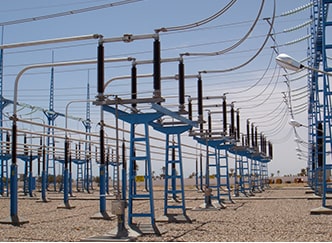The power transformer is designed to provide the reliability, durability and efficiency required in utility, industrial and commercial applications. Transformers are important components in our life today and they make large electrical systems possible. To efficiently transfer hundreds of megawatts of power over long distances, very high line voltages are required, in the range of 161 to 1000 kV.
What is a transformer?
A transformer is a passive electrical device designed to transfer alternating current (AC) from one electrical circuit to another, usually by the principle of mutual induction. During this process, the frequency remains constant. While the voltage can be increased or decreased as needed.
The transformer which increases the voltage between the primary and secondary windings is defined as a step-up transformer. And a transformer that decreases the voltage between the primary and secondary windings is a step-down transformer. Whether the transformer increases or decreases the voltage level depends on the relative number of turns between the primary and the secondary of the transformer.
Transformers are completely static and cannot be moved due to their solid state. Besides, it can last a long time without developing any defect under normal working condition. Without transformers, it would be impossible to develop the large electrical systems that exist today. Transformers can be classified in different types and in different ways, depending on their purpose, use, construction, etc., one of which is the power transformer.
Characteristics of the power transformer
power transformers support a wide range of voltage levels with applications in generation, transmission and distribution
The power transformer is economical. Indeed, the use of rigid and precise materials in power transformers guarantees low losses in the magnetic core and even in the windings. This results in lower operating costs.
The transformer is used to control the fluctuation of high or low voltages. In addition, it is reliable due to its advanced technology incorporated into the manufacturing process of the windings.
Power transformers have more than one primary and secondary winding. Thus, they can be shaped in a single-phase primary configuration or in a three-phase configuration.
Maximum security. Because all power transformers are made by air cooling and without any insulation.
Classifications of power transformers
Power transformers cover the population of the largest transformer units by means of rated powers and voltages. Thus, there are several different classifications of power transformers according to their rated powers and voltages. Or their size, and / or depending on the application.
Power transformers are classified into three types based on ranges. Indeed, these are large power transformers, medium power transformers and small power transformers.
Small power transformers (SPT)
Small Power Transformers (SPT) Transformers range from 500 to 7,500 kVA.
Medium power transformer (MPT)
Medium Power Transformers (MPT) This group includes transformers with a power range of 7,500 to 100 MVA
Large power transformer (LPT)
This group covers the largest units of the power transformer population. And this, with a power normally ranging from 100 to 200 MVA and more.
What are the applications of the power transformer?
Electrical energy is one of the major elements of our daily life on which we rely. Indeed, no one can imagine a way of life without electrical energy / electricity. In this way, these power transformers are useful in a transmission network to increase or decrease the voltage levels.
Discover the many applications of power transformers:
- Electricity production and distribution stations.
- Measurements (as voltage and current transformers).
- Control circuits (lower to power circuits with low voltage like 24, 12 VAC).
- Power transformers in substations before transmission to large industrial consumers.
- Energy distribution (switch from medium voltage to low voltage)
- Use in industry, on platforms, ships and under the sea.
- Power stations and buildings.
- Reduce power losses when transmitting electrical energy.
- The raising and lowering of high voltage.
Not to mention that the power transformer is a perfect choice in cases of long distance consumption. As well as in cases where the load is operating at full capacity 24 × 7.
Contact SOGES for all your projects requiring power transformers. Because we have a complete line of power transformers designed to provide the reliability, durability and efficiency required in utility, industrial and commercial applications. In addition, our power transformers are designed and manufactured to the highest quality standards to ensure long lasting reliability.



